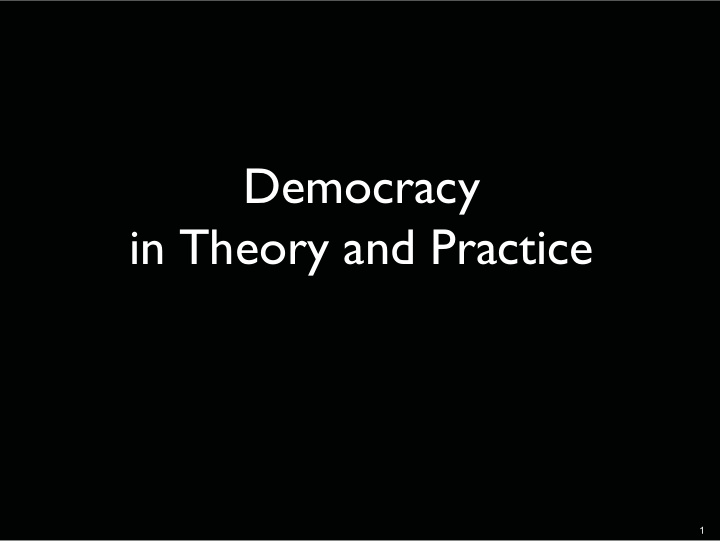



Democracy in Theory and Practice 1
The Politics of Confrontation in1950s - Liberal/Democratic Party (LDP) vs Japan Socialist Party (JSP) and JCP L/DP vote %; seat % JSP vote % seats% JCP vote % seats 1952 66 21 24 2 5 0 70 1953 66 66 27 30 2 1 1955 63 29 33 2 2 64 1958 58 62 33 36 2 5 1 1960 58 63 36 35 3 3 Need % for constitutional revision -2017 pro-revision forces (LDP/K6meit6 coalition+Nippon Ishin no kai): 342/475 (H Rep) 163/242 (H Co ) 2
The Politics of Confusion A haiku from the 90s� During the time ����� Of �ust one Clinton ����� ��� Seven Prime Ministers 3
11 Prime Ministers in 2 Decades • Kaifu Toshiki 1989 8-1991 11 (LDP) • Miyazawa Kiichi 1991 11-1993 8 (LDP) • Hosokawa Morihiro 1993 8-1994 4 (non-LDP coal ) • Hata Tsutomu 1994 4-1994 6 (non-LDP coal ) • Murayama Tomiichi 1994 6-1996 1 (JSP-LDP coal ) • Hashimoto Ryutar6 1996 1-1998 7 (LDP) • Obuchi Keiz6 1998 7-2000 4 (LDP) • Mori Yoshihiro 2000 4-2001 4 (LDP) • Koizumi Junichir6 2001 4-2006 9 (LDP) • Abe Shinz6 2006 9-2007 9 (LDP) • Fukuda Yasuo 2007 9-2008 9 (LDP) • As6 Tar6 2008 9-2009 9 (LDP) • Hatoyama Yukio 2009 9-2010 6 (DPJ) • Kan Naoto 2010 6-2011 9 (DPJ) 4
Disintegration of LDP Ma�ority • Corruption: Lockeed Incident (1974) "Recruit Incident" (1988) "Sagawa Express Incident" (1992) • Discontent with LDP hegemony � Unequal distribution of wealth � Reliance on rural vote through gerrymandering � Reliance on organizational vote 5
Losing Elections • 1989: Loss of House of Councilors (upper house) for the first time due to financial/sex scandals and introduction of unpopular tax • 1993: Opposition's "vote of no confidence" passes with support of LDP defectors lead by Ozawa Ichir6 � Rise of first non-LDP government since 1947 � PM Hosokawa Morihiro (Konoe Fumimaro's grandson) 6
LDP Comeback (Sort of) • June 1994: LDP-JSP(�) coalition under Socialist PM Murayama Tomiichi • 1996: LDP-only government formed � Opposition coalesce into Democratic Party of Japan (DPJ) • LDP back in government but still weak 7
"Koizumi Reforms" • "I'll break down the LDP if that's what it takes " • Reforming financial sector for economic recovery • Privatizing postal system: �3 trillion of savings 8
�ood Timing� • �DP grows • Unemployment: 5 5� (2002) to 4 2� (2006) • Tokyo Stock Exchange: from �140 to �160 9
Anomaly Among the 11 PMs • Second longest term since Mei�i: 2001-2006 5 5 yrs • September 2005: LDP landslide in the "Postal Reform Election" � wins 296 of 480 seats in lower h • Opposition sunk into oblivion by "Koizumi Theater" 10
Post-Koizumi Anxiety • Critique of "neo-liberal" Koizumi reforms • �rowing socioeconomic inequality in a "stratified society": -Emergence of winners/losers •Education •Income • �rowing sense of insecurity 11
Towards a Two-Party System(�) • Koizumi followed by three unpopular LDP PMs • 2007 upper house election: DPJ ma�ority • 2009 9 lower house election: DJP landslide � 308 out of 480 (bigger than Koizumi's 2005 victory) � Promise reform with safety net; primacy of politicians over bureaucracy; assertive stance viz U S � PM Hatoyama Ichir6 resigns in 8 months � PM Kan Naoto succeeds only to lose upper house ma�ority in July 2010 • Heavily criticized for post-earthquake response and resigns � LDP comeback in another landslide in 2012: Abe 2 0 •On course to beat Koizumi's record (5 5 yrs)� 12
Abe Shinz6: "Illiberal Revisionist" (or the Last Liberal Standing�) � Image by Lawrence Jackson. This image is in the public domain. Source: Wikimedia Commons. 13
MIT OpenCourseWar e http s ://ocw.mit.edu 21H.155 Modern Japan: 1868 to Present Spring 20 17 For information about citing these materials or our Terms of Use, visit: http s ://ocw.mit.edu/terms.
Recommend
More recommend